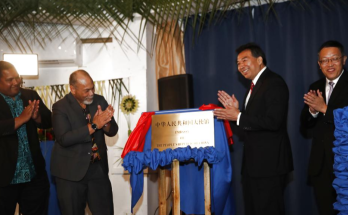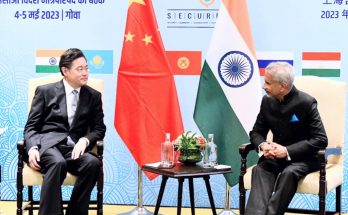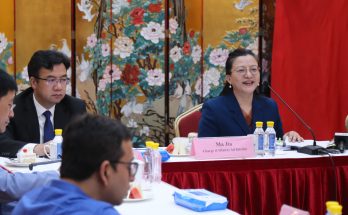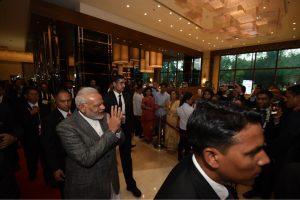 MANILA: It’s ASEAN moment in the Philippines capital – sparkling lights, giant Christmas tree and ASEAN emblems splashed all over this bustling metropolis conjure up a festive atmosphere that’s in keeping with the 50th anniversary celebrations of this vibrant grouping of 10 Southeast Asian nations. And Philippines’ maverick leader Roderigo Duterte has launched a veritable charm offensive as he rolls out the red carpet to welcome a host of world leaders, including US President Donald Trump, India’s Prime Minister Narendra Modi and Chinese Premier Li Keqiang, among others, for this defining marker in the history of ASEAN.
MANILA: It’s ASEAN moment in the Philippines capital – sparkling lights, giant Christmas tree and ASEAN emblems splashed all over this bustling metropolis conjure up a festive atmosphere that’s in keeping with the 50th anniversary celebrations of this vibrant grouping of 10 Southeast Asian nations. And Philippines’ maverick leader Roderigo Duterte has launched a veritable charm offensive as he rolls out the red carpet to welcome a host of world leaders, including US President Donald Trump, India’s Prime Minister Narendra Modi and Chinese Premier Li Keqiang, among others, for this defining marker in the history of ASEAN.
Behind bonhomie, serious issues
Celebrations and festivities are in order, but behind all this bonhomie and camaraderie lie a sense of unease and anxiety about festering geopolitical churn in the region. The 31st ASEAN summit in Manila is happening at a time amid competing power games by the US and China to consolidate their influence in the region, and a spate of crises like renewed posturing over the South China Sea and the North Korea nuclear crisis. The rise of virulent Islamic radicalism in the region, as exemplified in the terror siege in Marawi by the Islamic State, has already put security issues on top of the ASEAN agenda.
Manila summit: Stakes for India
 For India, the Manila summit will be an opportunity for Prime Minister Modi to underscore New Delhi’s strategic intent to play a bigger role in the region and impart more depth and content to its Act East policy. The India-ASEAN summit, scheduled to be held in Manila on November 14, is expected to impart a fresh momentum to step up the action plan for deepening and diversifying New Delhi’s multi-faceted partnership with the ASEAN and East Asia region against the backdrop of the growing salience of the Indo-Pacific in global geopolitical landscape.
For India, the Manila summit will be an opportunity for Prime Minister Modi to underscore New Delhi’s strategic intent to play a bigger role in the region and impart more depth and content to its Act East policy. The India-ASEAN summit, scheduled to be held in Manila on November 14, is expected to impart a fresh momentum to step up the action plan for deepening and diversifying New Delhi’s multi-faceted partnership with the ASEAN and East Asia region against the backdrop of the growing salience of the Indo-Pacific in global geopolitical landscape.
PM Modi is expected to invite the leaders of all 10 ASEAN countries for the special India-ASEAN commemorative summit in New Delhi in January 2018. This summit will be a milestone in India’s blossoming relations with ASEAN as this is the first time India will be hosting the leaders of all 10 ASEAN countries as Guest of Honour at the annual Republic Day parade.
Sea of Trouble
On the strategic side, all eyes will be on the message coming out from the ASEAN summit on the South China Sea, where China’s suspected expansionist agenda has renewed anxiety about Beijing’s intentions and the region’s response to it. Ahead of the summit, Mr Duterte has already voiced his concerns and underlined the need for a written code of conduct that will ensure responsible behaviour by China in the disputed water body.
The meeting between Mr Duterte and the Chinese premier will be watched closely as Beijing renews its diplomatic push to build brides with Manila and allays the latter’s concerns. In an article published in The Manila Times, Chinese Premier Li Keqiang has outlined a big-picture canvas of China-Philippines relations and stressed that although the two sides have “different views on certain issues,” “they returned to the track of appropriately handling the South China issue through dialogue and consultation, this removing the stumbling block in China-Philippines relations.” Against this backdrop, PM Modi is expected to make a strong pitch for maintaining and upholding freedom of navigation and keeping sea lanes of communication free from geopolitical rivalries. What Mr Trump says on the South China Sea issue at the Manila summit – he was studiously silent on it during his recent visit to China – will have a profound bearing on how this issue plays out in the future.
Quad Balancer
The larger strategic issue at stake at the Manila summit will be on shaping an inclusive regional architecture in the Indo-Pacific region. In this regard, the first-ever quadrilateral meeting of officials of India, Japan, US and Australia on the Indo-Pacific region in Manila on November 12 is specially significant. The Quadrilateral is widely seen as a coalition of maritime democracies to counter China’s expansionist agenda in Beijing. Officially, all the four countries have denied any China containment, but the Quad can be expected to play the role of a pressure group in curbing China’s assertive tendencies in the region.
Regional Counter-terror Cooperation
Another important priority for India will be to join hands with ASEAN in curbing the increasing scourge of terrorism in the region. The Marawi terror siege has imparted an added urgency to enhancing regional counter-terror cooperation. One can expect India to back ASEAN-driven initiatives to bolster regional counter-terror infrastructure and capability. In his speech at the India-ASEAN summit, PM Modi could announce his plan to host a conference on de-radicalisation of ASEAN countries to which all member ASEAN countries will be invited. The conference could be held before the end of the year, or before the special India-ASEAN summit in January 2018.
Economic Ties: RCEP
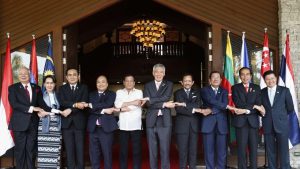 On the economic side, with the Indian economy recovering its growth rate after relative slowdown in the last quarter, India will be pitching for enhanced investment from ASEAN countries. In his speech at ASEAN Business and Investment Summit in Manila on November 13, PM Modi is going to showcase path-breaking economic reforms initiated by his government that has led to enhanced ease of doing business. India’s World Bank ranking in ease of doing business recently jumped 40 places. Bilateral trade between India and ASEAN surpassed US$ 71 billion in 2016-17.
On the economic side, with the Indian economy recovering its growth rate after relative slowdown in the last quarter, India will be pitching for enhanced investment from ASEAN countries. In his speech at ASEAN Business and Investment Summit in Manila on November 13, PM Modi is going to showcase path-breaking economic reforms initiated by his government that has led to enhanced ease of doing business. India’s World Bank ranking in ease of doing business recently jumped 40 places. Bilateral trade between India and ASEAN surpassed US$ 71 billion in 2016-17.
In unlocking the potential of India’s economic ties with the ASEAN and East Asia region, the Regional Comprehensive Economic Partnership (RCEP) could play an important role. At the RCEP leaders’ summit in Manila on November 14, PM Modi is expected to underline India’s commitment to RCEP, but at the same time he is expected to emphasise the need for a balanced outcome. India has all-too-real concerns about key provisions in RCEP, especially those relating to services trade and IPRs.
The Way Ahead
Looking ahead, as they celebrate 25 years of multifarious engagement across the spectrum, India and ASEAN will be looking to map new frontiers and raise the bar for this mutually empowering partnership. The message coming from the Manila summit will have a critical bearing on the future of this economically dynamic region and how it handles differences and power games to focus on the larger dream of realising the potential of an Asian Century.
(Manish Chand is CEO and Editor-in-Chief of India Writes Network and India and World, a pioneering magazine focused on international affairs. He is in Manila for the 31st ASEAN and related summits)
Author Profile

- Manish Chand is Founder-CEO and Editor-in-Chief of India Writes Network (www.indiawrites.org) and India and World, a pioneering magazine focused on international affairs. He is CEO/Director of TGII Media Private Limited, an India-based media, publishing, research and consultancy company.
Latest entries
 India and the WorldMarch 3, 2024India-Denmark Connect: Red carpet for Indians to Red Sea cooperation
India and the WorldMarch 3, 2024India-Denmark Connect: Red carpet for Indians to Red Sea cooperation India and the WorldFebruary 17, 2024Munich Security Conference: Jaishankar, Blinken focus on Red Sea, Middle East
India and the WorldFebruary 17, 2024Munich Security Conference: Jaishankar, Blinken focus on Red Sea, Middle East India and the WorldFebruary 14, 2024Munich Security Conference report: Migration, war top security threats
India and the WorldFebruary 14, 2024Munich Security Conference report: Migration, war top security threats India and the WorldJanuary 23, 2024With “Ram to Rashtra” mantra, Modi consecrates Ram temple for national renewal
India and the WorldJanuary 23, 2024With “Ram to Rashtra” mantra, Modi consecrates Ram temple for national renewal





